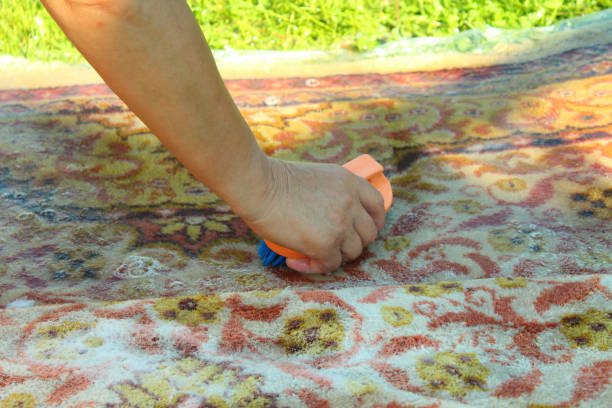You may “bleed” from a rug for several reasons. We’ll look at scenarios involving a wool carpet like this, where the red dyes migrated to the adjacent off-white areas.
What could cause this type of dye migration? Several things could drive this type of dye migration.
Fugitive DIESES: If the dye is not colorfast in your test, it may bleed if improperly exposed to water, such as from a flood. Your dye testing will reveal this potential risk. You can then decide which dye-stabilizing solution and shampoo to use.
If the rug was not cleaned previously, it may have a little “excess dye” in the fibers. This could wash out with the first cleaning, much like a colorful shirt that you put in the washing machine. If the color was added after the rug had been woven, either to make it more vibrant (or make it appear older with tea-wash antiquing), this extra dye or ink may bleed when cleaned.
You can use the dye-stabilizing solution to protect adjacent areas if you have excess dye.
You cannot protect adjacent areas from over-dyed rugs like those with India Ink. To avoid a catastrophe, it is important to identify them before cleaning. These rugs can often crock up color just by using a dry cloth. They also transfer the color with the dye test. Dye stabilizers only work with DYES, not inks.
High Heat or Alkalinity: A colorfast dye can bleed even when properly applied with a dye-stabilizing product if the dye is combined improperly with high temperatures during cleaning or with alkaline cleaning products (such as those used for traffic lane cleaners). If you plan to clean the rug outside of recommended pH and temperature ranges, always test the dye with that temperature/alkalinity to ensure you do not create dye damage.
Past in-home cleaning of rugs: The biggest problem is the residue left in the fibers. This residue tends to be alkaline and can, over time, affect acid dyes, especially in wool rugs. It can cause a “bleeder.” The dyes might bleed on the third time, even though the first two cleanings were fine. The buildup of residue from previous cleanings is the cause.
Never clean a rug in your home if it is valuable. Natural fiber rugs should be cleaned.
Pet urine is acidic initially but becomes alkaline after a few weeks or months. It is important to clean up any pet urine stain immediately. This will cause permanent dye damage and devalue your rug. No matter how hard you try to prevent it, urine will still bleed through the dyes in a rug. The most dangerous “spills” on rugs are pet urine. You should clean up the puddles immediately, especially if your rugs are valuable.

